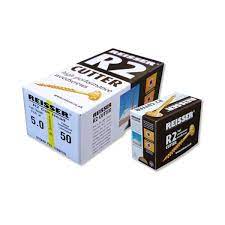The history of the screw

Fasteners are used to mechanically join two or more objects together, either permanently or non-permanently. There are many different types of fastener, each with their own purpose. There are many different types of fasteners.
Threaded fasteners are one of the most commonly used for assembling components as they can easily be installed and uninstalled as needed. There are three main types of threaded fastener; Bolts, Screws and Studs. Bolts have a head on one end (this is usually a hex head) and are threaded on the other. They are generally used in conjunction with a nut (and sometimes a washer) to hold them in place.
Screws are similar to bolts in that they have a head on one end and a thread on the other. They key difference is that screws are usually used to screw into an internally threaded hole. There are many different types of screws, such as Cap Screws, Machine Screws, and Woodscrews.
Studs are threaded on both ends, and therefore have no head. They are used to join two components with internally threaded holes together.
In addition, nuts are used in conjunction with a bolt to clamp two or more parts together. The most common type of nut is a Hexagonal Nut, but there are several different types of nuts for use in different applications.
Lock nuts are used when the nut needs to be locked in place without clamping on to another object. Hex Nuts are a plain, hexagonal nut with an internal thread. These are by far the most common type of nut, and are used in numerous industries and applications.
Many of the workman’s tools we use today were invented during the Roman Age or even before. Author Witold Rybczynski discovered that all of these tools were invented during the Roman age if not before. The chisel dates from the Bronze Age.
The screw firsts appears in machinery during the time of the Ancient Greeks, when screws were used in presses of various kinds.
Screws were first used in olive presses and grape presses. In the Middle Ages, this mechanism was adapted for use in the printing press and the paper press. The screw mechanism allows for tremendous force to be exerted on the object being pressed with minimal effort. For example, imagine a press whose large screw has a pitch of one inch and which is turned by means of a handspike three feet long. A pressure of only 40 pounds on the handspike will exert a pressure of more than nine thousand pounds on the olives or grapes.
Some of the earliest screws to be used as fasteners were used in military weapons. For example, screws were widely used in putting firearms together in the early 16th century.
Screws were originally used as fasteners for fixing two relatively thin pieces of material together.
We stock a variety of fasteners, fixings and screws at ProWeld Ireland. The Reisser Retinox 2 Stainless Steel Screws can be used in wood joints for indoor and outdoor areas as well as wet, damp areas. Its anti-friction coating reduces resistance when fastening.
Universal use, wood structures, fittings, terrace constructions etc.
Prices vary by screw size from €9.75-€51.84
We also offer the Reisser Cutter Wood Screws in a range of different sizes starting from 3.5 x 16mm all the way up to 6.0 x 180mm.
It allows screwing closer to the edge of timbers without splitting. Under the head are BOTH ribs and tucks enabling the screw to sit flush and tight without surface damage.
With the ability to penetrate almost all timbers without a pilot hole, this really is a screw worth using!
Costs €3.99-€65.95
Stainless Steel Countersunk Socket Head Cap Bolts available in various sizes which can be chosen below.
Please note, all countersunk bolts are measured from the top of the head to the end of the thread (the length of the entire bolt). Please keep this in mind when choosing your length.
Images used are for illustrative purposes only, and sometimes the actual product received may differ slightly to that shown.
Prices vary from €0.14-€1.69
